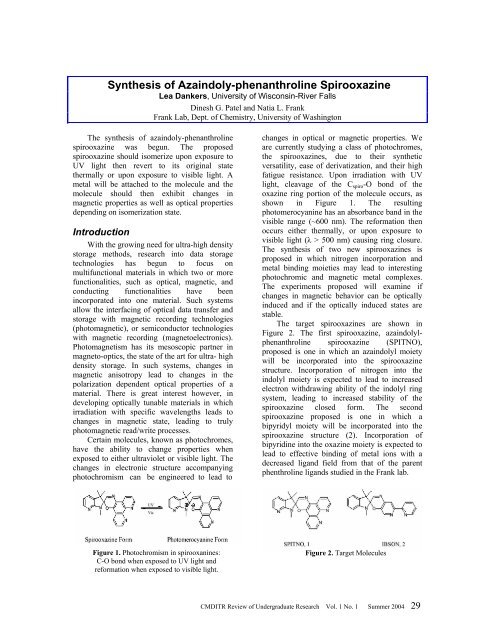CMDITR Review of Undergraduate Research - Pluto - University of ...
CMDITR Review of Undergraduate Research - Pluto - University of ...
CMDITR Review of Undergraduate Research - Pluto - University of ...
You also want an ePaper? Increase the reach of your titles
YUMPU automatically turns print PDFs into web optimized ePapers that Google loves.
Synthesis <strong>of</strong> Azaindoly-phenanthroline Spirooxazine<br />
Lea Dankers, <strong>University</strong> <strong>of</strong> Wisconsin-River Falls<br />
Dinesh G. Patel and Natia L. Frank<br />
Frank Lab, Dept. <strong>of</strong> Chemistry, <strong>University</strong> <strong>of</strong> Washington<br />
The synthesis <strong>of</strong> azaindoly-phenanthroline<br />
spirooxazine was begun. The proposed<br />
spirooxazine should isomerize upon exposure to<br />
UV light then revert to its original state<br />
thermally or upon exposure to visible light. A<br />
metal will be attached to the molecule and the<br />
molecule should then exhibit changes in<br />
magnetic properties as well as optical properties<br />
depending on isomerization state.<br />
Introduction<br />
With the growing need for ultra-high density<br />
storage methods, research into data storage<br />
technologies has begun to focus on<br />
multifunctional materials in which two or more<br />
functionalities, such as optical, magnetic, and<br />
conducting functionalities have been<br />
incorporated into one material. Such systems<br />
allow the interfacing <strong>of</strong> optical data transfer and<br />
storage with magnetic recording technologies<br />
(photomagnetic), or semiconductor technologies<br />
with magnetic recording (magnetoelectronics).<br />
Photomagnetism has its mesoscopic partner in<br />
magneto-optics, the state <strong>of</strong> the art for ultra- high<br />
density storage. In such systems, changes in<br />
magnetic anisotropy lead to changes in the<br />
polarization dependent optical properties <strong>of</strong> a<br />
material. There is great interest however, in<br />
developing optically tunable materials in which<br />
irradiation with specific wavelengths leads to<br />
changes in magnetic state, leading to truly<br />
photomagnetic read/write processes.<br />
Certain molecules, known as photochromes,<br />
have the ability to change properties when<br />
exposed to either ultraviolet or visible light. The<br />
changes in electronic structure accompanying<br />
photochromism can be engineered to lead to<br />
changes in optical or magnetic properties. We<br />
are currently studying a class <strong>of</strong> photochromes,<br />
the spirooxazines, due to their synthetic<br />
versatility, ease <strong>of</strong> derivatization, and their high<br />
fatigue resistance. Upon irradiation with UV<br />
light, cleavage <strong>of</strong> the C spiro -O bond <strong>of</strong> the<br />
oxazine ring portion <strong>of</strong> the molecule occurs, as<br />
shown in Figure 1. The resulting<br />
photomerocyanine has an absorbance band in the<br />
visible range (~600 nm). The reformation then<br />
occurs either thermally, or upon exposure to<br />
visible light (λ > 500 nm) causing ring closure.<br />
The synthesis <strong>of</strong> two new spirooxazines is<br />
proposed in which nitrogen incorporation and<br />
metal binding moieties may lead to interesting<br />
photochromic and magnetic metal complexes.<br />
The experiments proposed will examine if<br />
changes in magnetic behavior can be optically<br />
induced and if the optically induced states are<br />
stable.<br />
The target spirooxazines are shown in<br />
Figure 2. The first spirooxazine, azaindolylphenanthroline<br />
spirooxazine (SPITNO),<br />
proposed is one in which an azaindolyl moiety<br />
will be incorporated into the spirooxazine<br />
structure. Incorporation <strong>of</strong> nitrogen into the<br />
indolyl moiety is expected to lead to increased<br />
electron withdrawing ability <strong>of</strong> the indolyl ring<br />
system, leading to increased stability <strong>of</strong> the<br />
spirooxazine closed form. The second<br />
spirooxazine proposed is one in which a<br />
bipyridyl moiety will be incorporated into the<br />
spirooxazine structure (2). Incorporation <strong>of</strong><br />
bipyridine into the oxazine moiety is expected to<br />
lead to effective binding <strong>of</strong> metal ions with a<br />
decreased ligand field from that <strong>of</strong> the parent<br />
phenthroline ligands studied in the Frank lab.<br />
Figure 1. Photochromism in spirooxanzines: C-O<br />
bond cleavage when exposed to UV light and<br />
reformation when exposed to visisble light.<br />
Figure 1. Photochromism in spirooxanines:<br />
C-O bond when exposed to UV light and<br />
reformation when exposed to visible light.<br />
Figure 2. Target Molecules<br />
<strong>CMDITR</strong> <strong>Review</strong> <strong>of</strong> <strong>Undergraduate</strong> <strong>Research</strong> Vol. 1 No. 1 Summer 2004 29




